Toronto Now Fastest Growing Metropolitan Area in the United States and Canada, City of Toronto Still Fastest Growing Central City
By: Diana Petramala and Hannah Chan Smyth
June 10, 2020
(PDF file) Print-friendly version available
In May, the U.S. Census Bureau released its latest population growth estimates for U.S. metropolitan areas and central cities for the 12 months ending July 1, 2019 (the 2019 estimates). Statistics Canada’s comparable estimates for the same 12 months were released in February.
This blog compares population growth in metropolitan areas and major central cities in Canada in 2019 with those south of the border.
The data shows that Toronto was the fastest growing metropolitan area in Canada and the U.S. last year, overtaking Dallas-Fort Worth Arlington for the top spot. The city of Toronto was once again the fastest growing central city.
In absolute numbers, Toronto was the fastest growing metropolitan area in 2019, surpassing Dallas-Fort Worth-Arlington – Montreal was sixth
A CUR blog last year showed that the Toronto metropolitan area was the second fastest growing metropolitan area in all of the U.S. and Canada in 2018, coming in behind Dallas-Fort-Worth Arlington.
Metropolitan Toronto grew by 127,575 persons in 2019, outpacing Dallas-Fort Worth Arlington which grew by 117,380 persons, to become the fastest growing metropolitan area in all of the U.S. and Canada (see Figure 1).
Metropolitan Montreal was the sixth fastest growing area, with a population increase of 65,205 persons (see Figure 1).
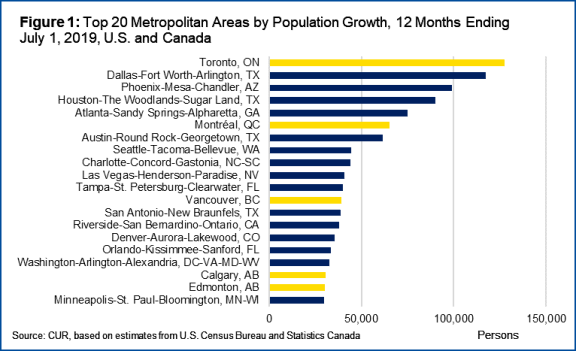
New York, Los Angeles and Chicago metropolitan areas had declines in population in the 12 months ending July 1, 2019
Metropolitan New York was the fastest contracting area in all of U.S. and Canada by a wide margin, with a population loss of 60,462 persons in the 12 months ending July 1, 2019. Los Angeles and Chicago metropolitan areas were second and third by population loss, with a loss of 35,080 and 25,619 persons respectively (see Figure 2).
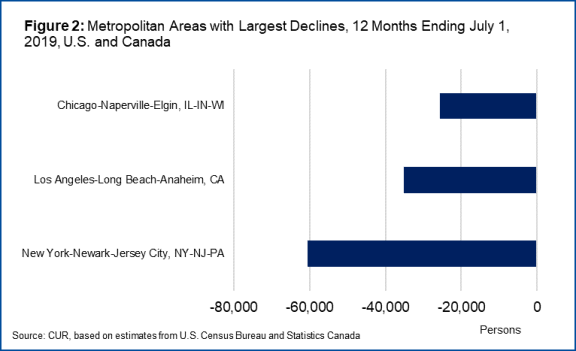
Toronto metropolitan area gets its strength in population growth from immigration
Figure 3 compares the components of population change in 2019 for the Toronto metropolitan area (the fastest growing metropolitan area) to the New York metropolitan area (the fastest declining metropolitan area). Toronto had almost three times as much population growth from immigration as New York in 2019. In addition, both regions experienced a loss in resident population to other areas (domestic net migration), but the rate was four times faster in New York.
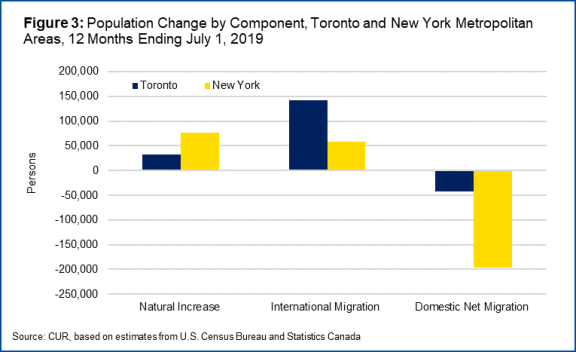
The city of Toronto was the leading city in population growth once again – Montreal was second
Toronto (45,742 persons) and Montreal (31,565 persons) represented the two fastest growing cities in all of the U.S. and Canada (see Figure 4) in the 12 months ending July 1, 2019. Overall, Canadian cities represented 11 of the top 20 central cities in the U.S. and Canada in population growth.
The growth in the city of Toronto’s exceeded the combined gains of the two fastest growing central cities in the United States. The two fastest growing central cities in the U.S. were the city of Phoenix and the city of San Antonio, which grew by 26,317 and 17,237 persons, respectively.
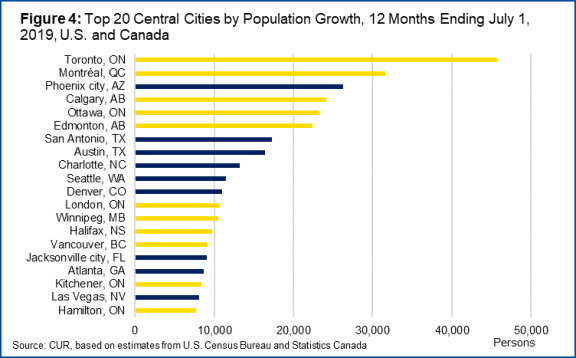
City of Toronto gained as much population as New York City lost
While the City of Toronto’s population grew by 45,742 persons, New York City’s population decreased by 53,264 in the 12 months ending July 1, 2019.
New York, Baltimore, Chicago, and San Jose were the bottom four U.S. and Canadian cities with the largest declines in population. New York had the largest population decrease by far, with a decrease of 53,264 compared to Baltimore’s 8,953 (see Figure 5).
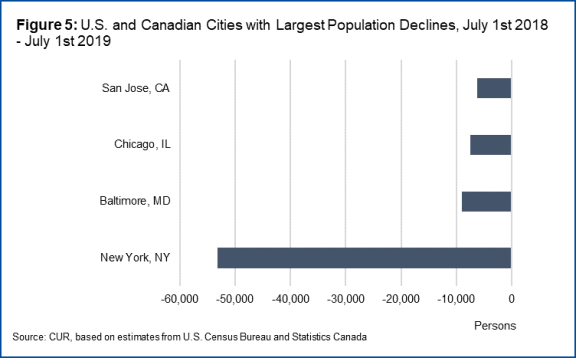
_________________________________________________________________________________________________________
Diana Petramala is Senior Researcher at Toronto Metropolitan University's Centre for Urban Research and Land Development (CUR) in Toronto.
Hannah Chan Smyth is a Research Assistant at Toronto Metropolitan University's Centre for Urban Research and Land Development (CUR) in Toronto.